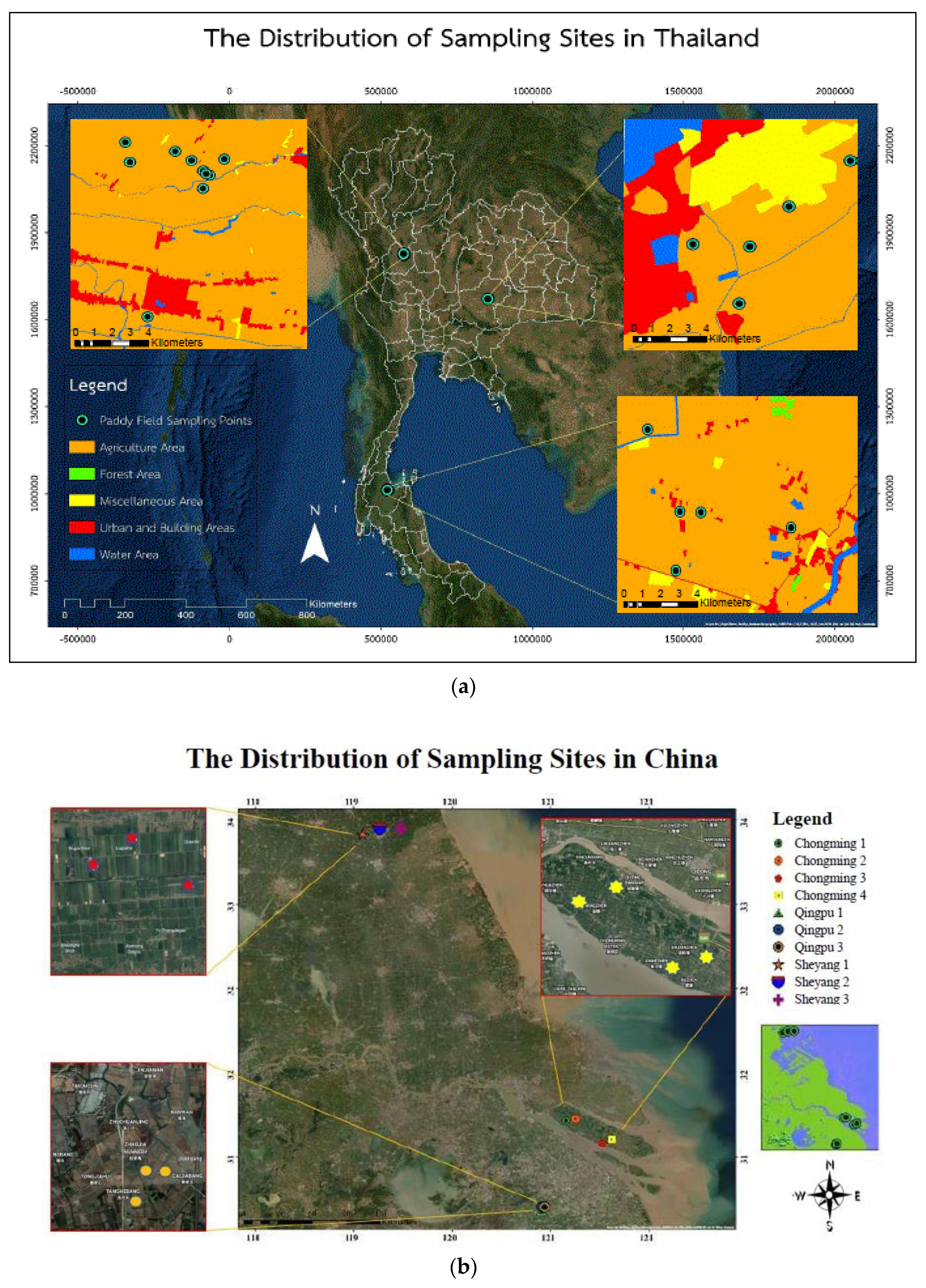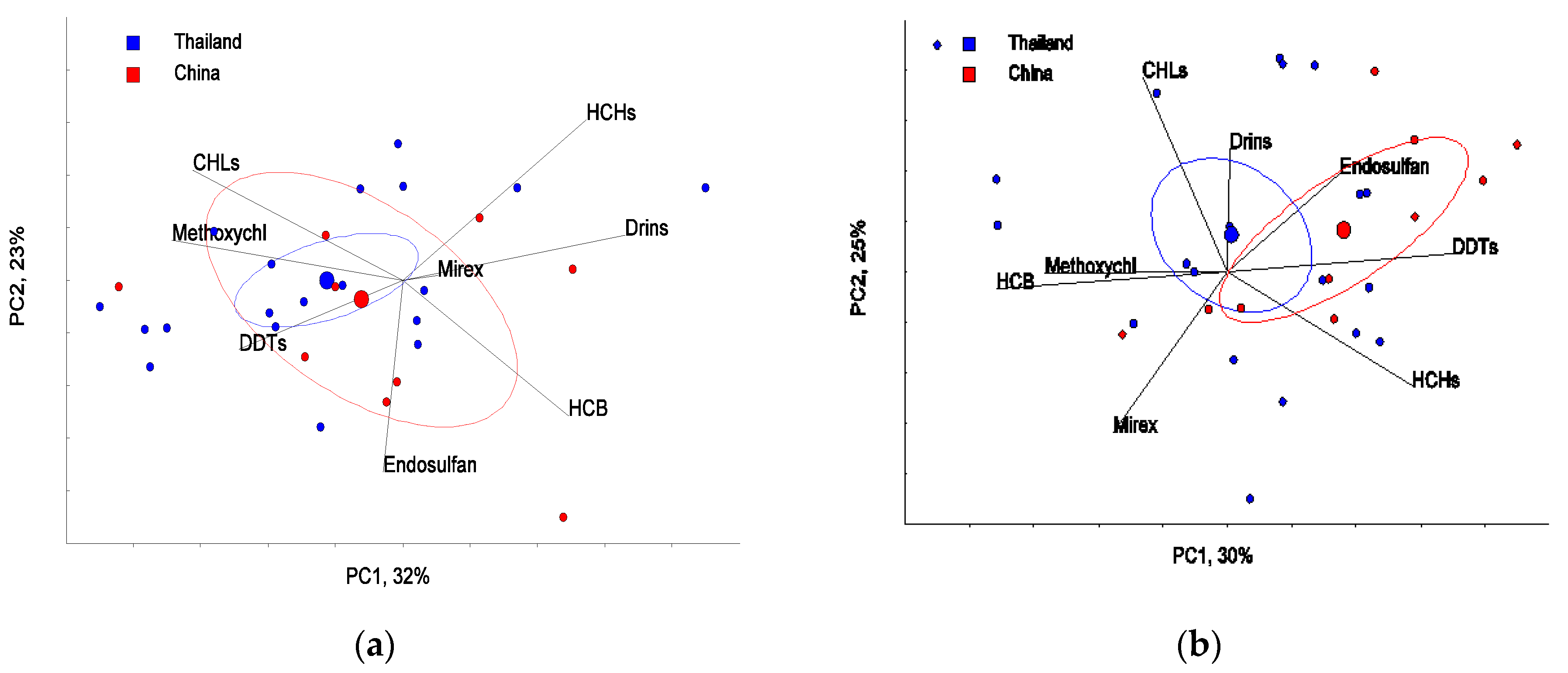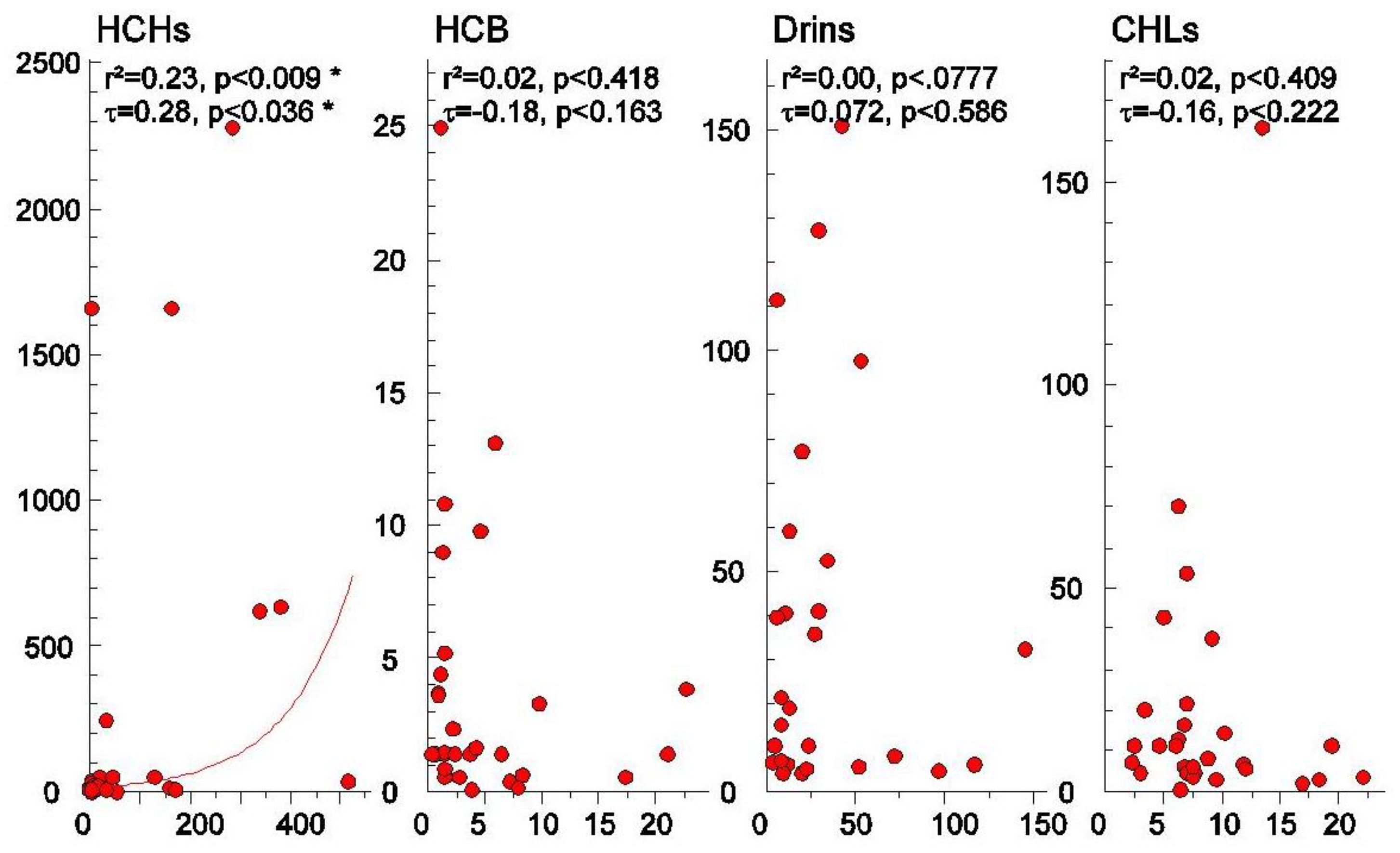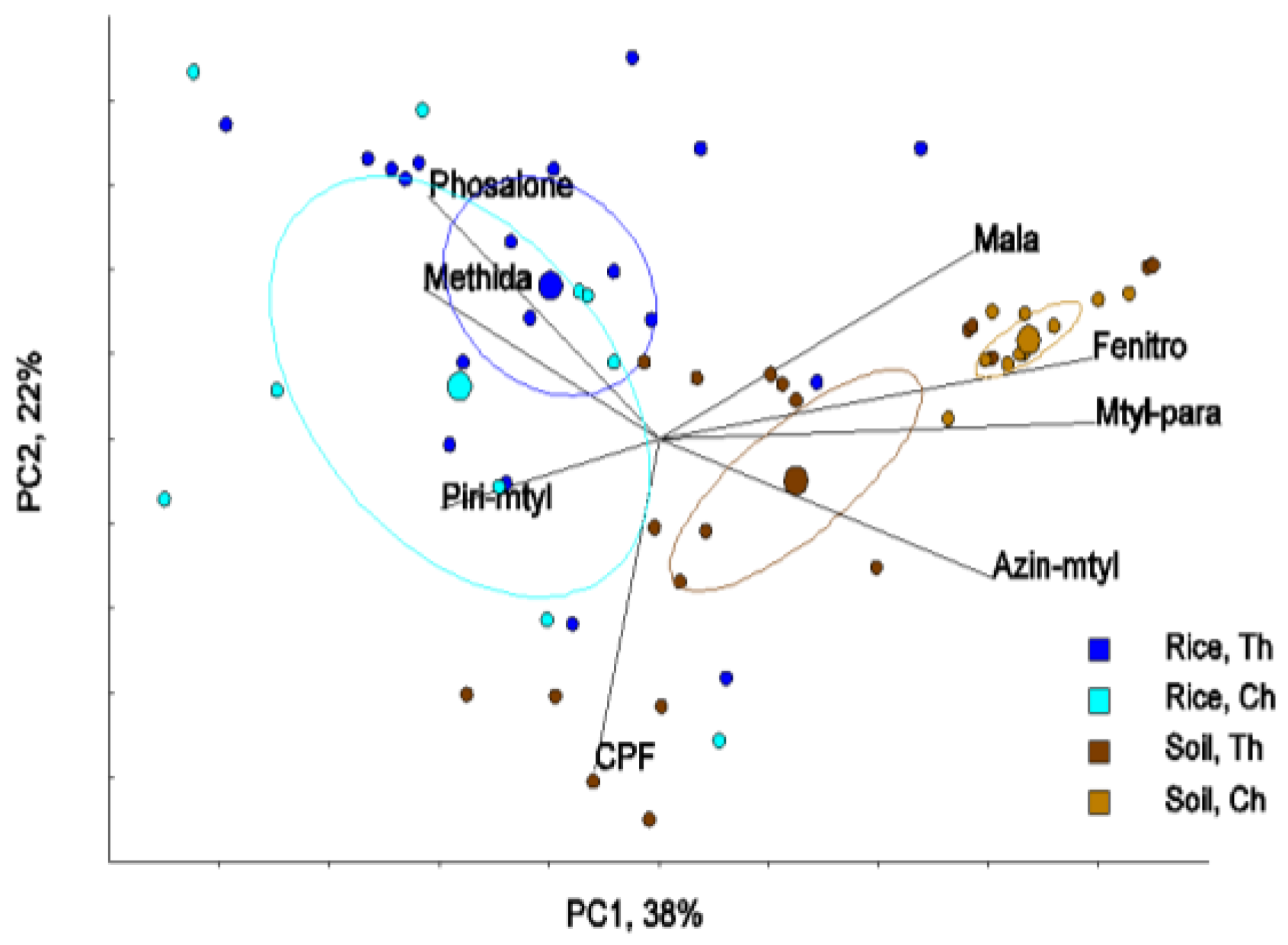Presence and Health Risks of Obsolete and Emerging Pesticides in Paddy Rice and Soil from Thailand and China
Abstract
1. Introduction
2. Materials and Methods
2.1. Study Area and Sample Collection
2.2. Chemicals and Reagents
2.3. Analytical Methods of OCPs
2.4. Analytical Methods of OPPs
2.5. Instrumental Analysis
2.6. Quality Assurance and Quality Control (QA/QC)
2.7. Statistical Analysis
3. Results
3.1. OCP and OPP Residues in Paddy Rice
3.2. OCP and OPP Residues in Paddy Soil
3.3. Potential Health Risks of OCPs and OPPs in Paddy Rice
4. Discussion
4.1. Presence of OCPs in Paddy Rice and Soil
4.2. Presence of OPPs in Paddy Rice and Soil
4.3. Bio-Concentration Factor of OCPs and OPPs between Paddy Rice and Soil
4.4. Patterns and Relative Concentrations of OCP and OPP between Paddy Rice and Soil
4.5. Correlation among TOC and Individual OCPs and OPPs
4.6. Potential Health Risks of OCPs and OPPs in Paddy Rice
5. Conclusions
Supplementary Materials
Author Contributions
Funding
Acknowledgments
Conflicts of Interest
References
- Tilman, D.; Cassman, K.G.; Matson, P.A.; Naylor, R.; Polasky, S. Agricultural sustainability and intensive production practices. Nature 2002, 418, 671. [Google Scholar] [CrossRef] [PubMed]
- 2018 Chinese Pesticide Exports Analysis-Southeast Asia. Available online: http://news.agropages.com/News/NewsDetail---29196.htm (accessed on 3 March 2018).
- Workman, D. Top Pesticides Exporters. 2018. Available online: http://www.worldstopexports.com/top–pesticides–exporters/ (accessed on 3 March 2018).
- Food and Agriculture Organization of the United Nations. Pesticides: Pesticides-Average Use Per Area of Cropland. 2017. Available online: http://www.fao.org/faostat/en/?#data/ (accessed on 1 April 2018).
- Ane, N.U.; Hussain, M. Diversity of insect pests in major rice growing areas of the world. J. Entomol. Zool. Stud. 2015, 4, 36–41. [Google Scholar]
- Darko, G.; Acquaah, S.O. Levels of organochlorine pesticides residues in dairy products in Kumasi, Ghana. Chemosphere 2008, 71, 294–298. [Google Scholar] [CrossRef] [PubMed]
- The Government of the Kingdom of Thailand. Plan for the Implementation of Its Obligation under the Stockholm Convention on the Persistent Organic Pollutants (POPs) in Thailand; Pollution Control Department: Bangkok, Thailand, 2007.
- Nakata, H.; Hirakawa, Y.; Kawazoe, M.; Nakabo, T.; Arizono, K.; Abe, S.K.; Kitano, T.; Shimada, H.; Watanabe, I.; Li, W. Concentrations and compositions of organochlorine contaminants in sediments, soils, crustaceans, fishes and birds collected from Lake Tai, Hangzhou Bay and Shanghai city region, China. Environ. Pollut. 2005, 133, 415–429. [Google Scholar] [CrossRef] [PubMed]
- Hongsibsong, S.; Kerdnoi, T.; Polyiem, W.; Srinual, N.; Patarasiriwong, V.; Prapamontol, T. Blood cholinesterase activity levels of farmers in winter and hot season of Mae Taeng District, Chiang Mai Province, Thailand. Environ. Sci. Pollut. Res. 2018, 25, 7129–7134. [Google Scholar] [CrossRef] [PubMed]
- Gupta, R.C.; Mukherjee, I.R.M.; Doss, R.B.; Malik, J.K.; Milatovic, D. Organophosphates and Carbamates. In Reproductive and Developmental Toxicology, 2nd ed.; Academic Press: Cambridge, MA, USA, 2017; pp. 609–631. [Google Scholar]
- Wongta, A.; Sawarng, N.; Tongchai, P.; Sutan, K.; Kerdnoi, T.; Prapamontol, T. The pesticide exposure of people living in agricultural community, Northern Thailand. J. Toxicol. 2018, 2018, 4168034. [Google Scholar] [CrossRef]
- Yimaer, A.; Chen, G.; Zhang, M.; Zhou, L.; Fang, X.; Jiang, W. Childhood pesticide poisoning in Zhejiang, China: A retrospective analysis from 2006 to 2015. BMC Public Health 2017, 17, 602. [Google Scholar] [CrossRef]
- Michelangelo, A.; Steven, J.L. Fast and Easy Multiresidue Method Employing Acetonitrile Extraction/Partitioning and “Dispersive Solid–Phase Extraction for the Determination of Pesticide Residue in Produce. J. AOAC Int. 2003, 86, 412–431. [Google Scholar]
- Khammanee, N.; He, J.; Qiu, Y.; Bignert, A.; Kungskulniti, N.; Niu, D.; Zhu, Z. Occurrence of Organochlorine Pesticides and Polychlorinated Biphenyls in soil with Various Land Uses from Shanghai, China. Fresenius Environ. Bull. 2018, 27, 5433–5445. [Google Scholar]
- Food and Agriculture Organization of the United Nations - Joint FAO/WHO Meeting on Pesticide Residues. 2012. Available online: http://www.fao.org/fao–who–codexalimentarius/en/ (accessed on 10 April 2018).
- Ministry of Agriculture and China Food and Drug Administration. National Food Safety Standard (GB 2763–2016): Maximum Residue Limits for Pesticides in Food. 2016. Available online: https://www.chinesestandard.net/PDF/English.aspx/GB2763–2016 (accessed on 10 April 2018).
- Ministry of Agriculture and Cooperatives Thailand and National Bureau of Agricultural Commodity and Food Standards. Thai Agricultural Standard (TAS 9002–2016): Pesticide Residues: Maximum Residue Limits. 2016. Available online: https://www.acfs.go.th/#/fs.go.th/#/ (accessed on 10 April 2018).
- European Commission. Pesticide: Maximum Residue Limits. 2016. Available online: https://ec.europa.eu/food/plant/pesticides/max_residue_levels_en (accessed on 9 April 2018).
- Agency for Toxic Substances and Disease Registry (ATSDR). Public Health Assessment Guidance Manual; Deparment of Health and Human Service PHS: Johnstown, NY, USA, 1995.
- Lunney, A.; Zeeb, B.; Reimer, K. Uptake of Weathered DDT in Vascular Plants: Potential for Phytoremediation. Environ. Sci. Technol. 2004, 38, 6147–6154. [Google Scholar] [CrossRef]
- Chen, S.; Shi, L.; Shan, Z.; Hu, Q. Determination of organochlorine pesticide residues in rice and human and fish fat by simplified two–dimensional gas chromatography. Food Chem. 2007, 104, 1315–1319. [Google Scholar] [CrossRef]
- Nakata, H.; Kawazoe, M.; Arizono, K.; Abe, S.; Kitano, T.; Shimada, H.; Li, W.; Ding, X. Organochlorine Pesticides and Polychlorinated Biphenyl Residues in Foodstuffs and Human Tissues from China: Status of Contamination, Historical Trend, and Human Dietary Exposure. Arch. Environ. Contam. Toxicol. 2002, 43, 0473–0480. [Google Scholar] [CrossRef] [PubMed]
- Toteja, G.S.; Mukherjee, A.; Diwakar, S.; Singh, P.; Saxena, B.N. Residues of DDT and HCH pesticides in rice samples from different geographical regions of India: A multicentre study. Food Addit. Contam. 2003, 20, 933–939. [Google Scholar] [CrossRef]
- Chaiyarat, R.; Sookjam, C.; Eiam-Ampai, K.; Damrongphol, P. Organochlorine pesticide levels in the food web in rice paddies of Bueng Boraphet wetland, Thailand. Environ. Monit. Assess. 2015, 187, 230. [Google Scholar] [CrossRef] [PubMed]
- Suresh Babu, G.; Farooq, M.; Ray, R.S.; Joshi, P.C.; Viswanathan, P.N.; Hans, R.K. DDT and HCH Residues in Basmati Rice (Oryza sativa) Cultivated in Dehradun (India). Water Air Soil Pollut. 2003, 144, 149–157. [Google Scholar] [CrossRef]
- Mumtaz, M.; Qadir, A.; Mahmood, A.; Mehmood, A.; Malik, R.N.; Li, J.; Yousef, Z.; Jamil, N.; Shaikh, L.A.; Ali, H.; et al. Human health risk assessment, congener specific analysis and spatial distribution pattern of organochlorine pesticides (OCPs) through rice crop from selected districts of Punjab Province, Pakistan. Sci. Total Environ. 2015, 511, 354–361. [Google Scholar] [CrossRef] [PubMed]
- Mahmood, A.; Malik, R.N.; Li, J.; Zhang, G. Human health risk assessment and dietary intake of organochlorine pesticides through air, soil and food crops (wheat and rice) along two tributaries of river Chenab, Pakistan. Food Chem. Toxicol 2014, 71, 17–25. [Google Scholar] [CrossRef] [PubMed]
- Hoai, P.M.; Sebesvari, Z.; Minh, T.B.; Viet, P.H.; Renaud, F.G. Pesticide pollution in agricultural areas of Northern Vietnam: Case study in Hoang Liet and Minh Dai communes. Environ. Pollut. 2011, 159, 3344–3350. [Google Scholar] [CrossRef]
- Yadav, I.C.; Devi, N.L.; Li, J.; Zhang, G.; Shakya, P.R. Occurrence, profile and spatial distribution of organochlorines pesticides in soil of Nepal: Implication for source apportionment and health risk assessment. Sci. Total Environ. 2016, 573 (Suppl. C), 1598–1606. [Google Scholar] [CrossRef]
- Zhou, Q.; Wang, J.; Meng, B.; Cheng, J.; Lin, G.; Chen, J.; Zheng, D.; Yu, Y. Distribution and sources of organochlorine pesticides in agricultural soils from central China. Ecotoxicol. Environ. Saf. 2013, 93, 163–170. [Google Scholar] [CrossRef]
- Mishra, K.; Sharma, R.C.; Kumar, S. Contamination levels and spatial distribution of organochlorine pesticides in soils from India. Ecotoxicol. Environ. Saf. 2012, 76, 215–225. [Google Scholar] [CrossRef] [PubMed]
- Guo, W.; Zhang, H.; Huo, S. Organochlorine pesticides in aquatic hydrophyte tissues and surrounding sediments in Baiyangdian wetland, China. Ecol. Eng. 2014, 67, 150–155. [Google Scholar] [CrossRef]
- Liu, W.-X.; He, W.; Qin, N.; Kong, X.-Z.; He, Q.-S.; Ouyang, H.-L.; Yang, B.; Wang, Q.-M.; Yang, C.; Jiang, Y.-J. Residues, Distributions, Sources, and Ecological Risks of OCPs in the Water from Lake Chaohu, China. Sci. World J. 2012, 16, 1–16. [Google Scholar] [CrossRef] [PubMed]
- Science and Technology Department of State Environmental Protection. Administration Environmental Quality Standard for Soils (GB15618–1995); Science and Technology Department of State Environmental Protection Administration: Beijing, China, 1995.
- Snyder, F.; Ni, L. A Tale of Eight Pesticides: Risk Regulation and Public Health in China. Eur. J. Risk Regul. 2017, 8, 469–505. [Google Scholar] [CrossRef]
- Washburn, A.D. The Environmental Fate of Methidathion. 2003. Available online: https://www.cdpr.ca.gov/docs/emon/pubs/fatememo/methidathion (accessed on 8 March 2018).
- Manirakiza, P.; Akinbamijo, O.; Covaci, A.; Pitonzo, R.; Schepens, P. Assessment of Organochlorine Pesticide Residues in West African City Farms: Banjul and Dakar Case Study. Arch. Environ. Contam. Toxicol. 2003, 44, 0171–0179. [Google Scholar] [CrossRef]
- Miglioranza, K.S.B.; Aizpún de Moreno, J.E.; Moreno, V.J.; Osterrieth, M.L.; Escalante, A.H. Fate of organochlorine pesticides in soils and terrestrial biota of “Los Padres” pond watershed, Argentina. Environ. Pollut. 1999, 105, 91–99. [Google Scholar] [CrossRef]
- Stadlinger, N.; Berg, H.; Van den Brink, P.J.; Tam, N.T.; Gunnarsson, J.S. Comparison of predicted aquatic risks of pesticides used under different rice–farming strategies in the Mekong Delta, Vietnam. Environ. Sci. Pollut. Res. 2016, 25, 13322–13334. [Google Scholar] [CrossRef]
- Ghanbari, F.; Monavari, F.; Monavari, S.M.; Arjmandi, R. Human health risk assessment of organophosphorus pesticide in rice crop from selected districts of Anzali International Wetland basin, Iran. Hum. Exp. Toxicol. 2017, 36, 438–444. [Google Scholar] [CrossRef]
- Bajet, C.M.; Tejada, A.W. Pesticide residues in the Philippines: An analytical perspective. Trends. Analyt. Chem. 1995, 14, 430–434. [Google Scholar] [CrossRef]
- Pan, H.W.; Lei, H.J.; He, X.S.; Xi, B.D.; Xu, Q.G. Spatial distribution of organochlorine and organophosphorus pesticides in soil–groundwater systems and their associated risks in the middle reaches of the Yangtze River Basin. Environ. Geochem. Health 2019, 41, 1833–1845. [Google Scholar] [CrossRef]
- Zhang, X.; Shen, Y.; Yu, X.-Y.; Liu, X.-J. Dissipation of chlorpyrifos and residue analysis in rice, soil and water under paddy field conditions. Ecotoxicol. Environ. Saf. 2012, 78, 276–280. [Google Scholar] [CrossRef] [PubMed]
- Tri, J.; Sutrisno, A.; Henna, R.S.; Savitri, R. Pesticides Usage in the Soil Quality Degradation Potential in Wanasari Subdistrict, Brebes, Indonesia. Appl. Environ. Soil Sci. 2017, 2017, 7. [Google Scholar] [CrossRef]
- Feng, K.; Yu, B.Y.; Wang, X.L.; Ge, D.M.; Wang, X.Z.; Wong, M.H.; Cao, Z.H. Distribution of Organo–Chlorine Pesticides (DDT and HCH) Between Plant and Soil System. Environ. Geochem. Health 2004, 26, 253–258. [Google Scholar] [CrossRef] [PubMed]
- Han, Y.; Mo, R.; Yuan, X.; Zhong, D.; Tang, F.; Ye, C.; Liu, Y. Pesticide residues in nut–planted soils of China and their relationship between nut/soil. Chemosphere 2017, 180, 42–47. [Google Scholar] [CrossRef] [PubMed]
- Fang, Y.; Nie, Z.; Yang, J.; Die, Q.; Tian, Y.; Liu, F.; He, J.; Wang, J.; Huang, Q. Spatial distribution of and seasonal variations in endosulfan concentrations in soil, air, and biota around a contaminated site. Ecotoxicol. Environ. Saf. 2018, 161, 402–408. [Google Scholar] [CrossRef]
- Jiang, Y.-F.; Wang, X.-T.; Jia, Y.; Wang, F.; Wu, M.-H.; Sheng, G.-Y.; Fu, J.-M. Occurrence, distribution and possible sources of organochlorine pesticides in agricultural soil of Shanghai, China. J. Hazard. Mater. 2009, 170, 989–997. [Google Scholar] [CrossRef]
- Akoto, O.; Oppong-Otoo, J.; Osei-Fosu, P. Carcinogenic and non–carcinogenic risk of organochlorine pesticide residues in processed cereal–based complementary foods for infants and young children in Ghana. Chemosphere 2015, 132, 193–199. [Google Scholar] [CrossRef]
- Zhang, Q.; Xia, Z.; Wu, M.; Wang, L.; Yang, H. Human health risk assessment of DDTs and HCHs through dietary exposure in Nanjing, China. Chemosphere 2017, 177, 211–216. [Google Scholar] [CrossRef]
- Zhang, C.Z.; Zhang, X.M.; Tian, Z.H.; He, D.J.; Liu, X.J. Degradation of Chlorpyrifos and Fipronil in rice from farm to fork and risk assessment. Agr. Sci. China 2010, 9, 754–763. [Google Scholar] [CrossRef]
- Lozowicka, B.; Kaczynski, P.; Paritova, A.E.; Kuzembekova, G.B.; Abzhalieva, A.B. Pesticide residues in grain from Kazakhstan and potential health risks associated with exposure to detected pesticides. Food Chem. Toxicol. 2014, 64, 238–248. [Google Scholar] [CrossRef]
- Tawatsin, A.; Thavara, U.; Siriyasatien, P. Pesticides Used in Thailand and Toxic Effects to Human Health. Med. Res. Arch. 2015, 3, 1–10. [Google Scholar] [CrossRef]
- Babina, K.; Dollard, M.; Pilotto, L.; Edwards, J.W. Environmental exposure to organophosphorus and pyrethroid pesticides in South Australian preschool children: A cross sectional study. Environ. Int. 2012, 48, 109–120. [Google Scholar] [CrossRef] [PubMed]
- Maryam, A.; Hassan, Y.; Fazad, K.; Shahram, S.; Morteza, P.-H.; Hossein, R. Exposure Assessment for Some Pesticides through Rice Consumption in Iran Using a Multiresidue Analysis by GC–MS. Iran. J. Pharm. Res. 2018, 17, 124–139. [Google Scholar]





| Location of Sampling Sites | Number of Paddy Soil | Number of Paddy Rice | Collection Time of Soil and Rice | Soil Texture |
|---|---|---|---|---|
| Khampaengphet, northern Thailand | 10 | 10 | April, 2015 | silty clay loam |
| Nakorn Ratchasima, northeastern Thailand | 5 | 5 | September, 2015 | sandy clay loam |
| Suratthani, southern Thailand | 5 | 5 | January, 2016 | clay |
| Qingpu, Shanghai, China | 3 | 3 | February, 2016 | clay |
| Sheyang, Jiansu, China | 3 | 3 | July, 2016 | silty clay loam |
| Chongming Island, Shanghai, China | 4 | 4 | July, 2016 | silty clay loam |
| p-Value | RC | ST | SC | |
|---|---|---|---|---|
| Bonferroni (p < 0.0083) adjusted alfa (0.05) | 0.0011 * | <0.0001 * | <0.0001 * | RT |
| 0.0094 | <0.0001 * | RC | ||
| 0.0035 * | ST |
© 2020 by the authors. Licensee MDPI, Basel, Switzerland. This article is an open access article distributed under the terms and conditions of the Creative Commons Attribution (CC BY) license (http://creativecommons.org/licenses/by/4.0/).
Share and Cite
Khammanee, N.; Qiu, Y.; Kungskulniti, N.; Bignert, A.; Meng, Y.; Zhu, Z.; Lekew Teffera, Z. Presence and Health Risks of Obsolete and Emerging Pesticides in Paddy Rice and Soil from Thailand and China. Int. J. Environ. Res. Public Health 2020, 17, 3786. https://doi.org/10.3390/ijerph17113786
Khammanee N, Qiu Y, Kungskulniti N, Bignert A, Meng Y, Zhu Z, Lekew Teffera Z. Presence and Health Risks of Obsolete and Emerging Pesticides in Paddy Rice and Soil from Thailand and China. International Journal of Environmental Research and Public Health. 2020; 17(11):3786. https://doi.org/10.3390/ijerph17113786
Chicago/Turabian StyleKhammanee, Naranun, Yanling Qiu, Nipapun Kungskulniti, Anders Bignert, Yuan Meng, Zhiliang Zhu, and Zebene Lekew Teffera. 2020. "Presence and Health Risks of Obsolete and Emerging Pesticides in Paddy Rice and Soil from Thailand and China" International Journal of Environmental Research and Public Health 17, no. 11: 3786. https://doi.org/10.3390/ijerph17113786
APA StyleKhammanee, N., Qiu, Y., Kungskulniti, N., Bignert, A., Meng, Y., Zhu, Z., & Lekew Teffera, Z. (2020). Presence and Health Risks of Obsolete and Emerging Pesticides in Paddy Rice and Soil from Thailand and China. International Journal of Environmental Research and Public Health, 17(11), 3786. https://doi.org/10.3390/ijerph17113786






